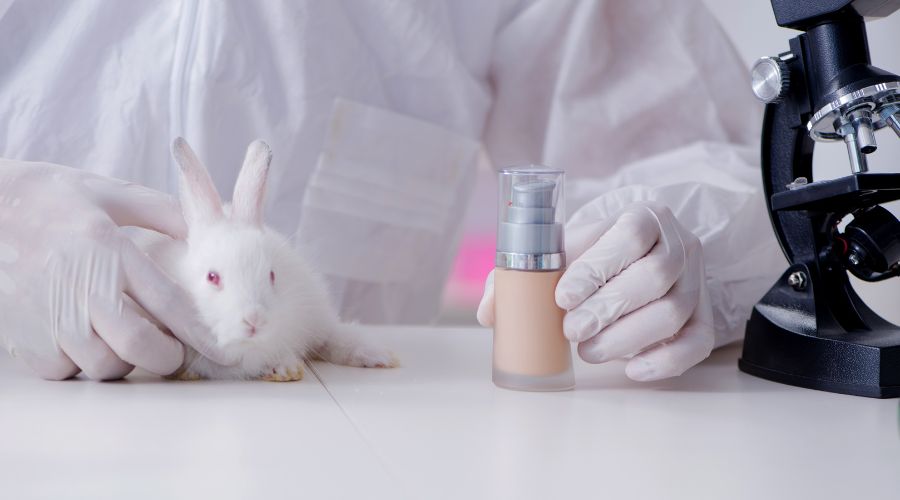
“Not tested on animals.”
You’ve probably seen these words on a beauty product or an apparel brand. But what is animal testing?
Animal testing involves using non-human animals in experiments and tests. For products to be considered safe for human consumption, they are tested on animals first. The products are tweaked and continually tested on animals until they are ready to be sold to the public.
Animal testing isn’t just for products. It’s also used for medical procedures and research. Not all experiments lead to injury or death of the animals used, but even so-called mild procedures can cause physical and psychological distress.
The most common animals used for research are mice and rats. Other animals used for product testing include dogs, cats, monkeys, pigs, sheep, guinea pigs, rabbits, hamsters, bats, and many other species.
The animals are usually alive while being tested. They are kept inside or near the research facilities. Some animals are bred specifically to be experimented on. They’ll never know what life outside of captivity is like.
Not familiar with animal testing and the suffering it causes animals? Check out these animal testing facts (they’re not easy to read) to be aware of what’s going on so that you can better advocate for animals.
General Facts About Animal Testing
1. Half a million tests found to cause suffering
Over 560,000 animal experiments have been found to cause considerable suffering. The animals being used experience pain and distress throughout the experiments, lasting anywhere between a few days and numerous months. Often it leads to the death of the animals involved.
2. Over 100 million animals tested in the US
Over 100 million animals are tested and experimented on in the United States alone each year. Even with the existence of the Animal Welfare Act (AWA), 800,000 animals, including dogs, cats, farm animals, monkeys, and others, are continuously subjected to regulated animal experiments.
3. Unregulated animal testing is going on
The United States does not label particular creatures as animals, legally speaking. According to the AWA, dogs, cats, monkeys, guinea pigs, hamsters, and other warm-blooded creatures are animals. This excludes cold-blooded animals and a significant number of other animals. It allows for the unregulated testing of animals excluded by the AWA. This means that well over 100 million animals are being used for testing yearly.
4. Dogs, cats, and monkeys make up 20% of animals in regulated studies
According to animal testing statistics, of the 800,000 animals subjected to regulated testing, dogs, cats, and monkeys make up 20% of the population. That’s about 150,000 animals subjected to lab experiments. Labs usually test on pets thanks to their docile and trusting nature because they are less likely to fight back. Monkeys are a popular animal for experiments because of their genetic closeness to human beings.
5. Globally nearly 200 million animals are experimented on
Over 192 million animals are used in scientific research, according to a 2015 worldwide count. The United States is responsible for over half of that number.
6. The majority of products that use animal testing don’t make it to the shelves
More than 90% of products that pass animal tests fail to make it to the market. These stats on animal testing makes the practice even crueler. With such a high failure rate, there is no rational reason to allow this practice to continue. Still, it continues to remain popular around the world.
7. Many animals are euthanized
Once the experiments are done, corporations and scientists are left with injured, disabled, and traumatized animals that can’t be put up for adoption. In addition, most animals used in experiments, such as mice, rats, and reptiles, are not considered pets by the public. Animals that are deemed unadoptable are then euthanized. Some animals are killed before the experiments begin if the labs have a surplus supply of test subjects.
Cosmetic Animal Testing Facts
8. The majority of animal testing is done in the cosmetic industry
Cosmetic animal testing statistics suggest that over 115 million animals are tested in the cosmetics industry worldwide. The number is, of course, only an estimate as many countries have different laws regarding cosmetic animal testing.
9. Cosmetic animal testing is not legally mandated
The Federal Food, Drug, and Cosmetic Act doesn’t require animal testing for makeup and cosmetic products to be considered safe for humans. This means that companies using animals do it because they want to and not because they have to. Most cosmetics products are already found to be safe for humans, making animal testing even more unnecessary.
10. The nature of the tests
There are generally three types of cosmetic animal tests done. The first is skin and eye irritation tests. The second test involves feeding the animal doses to see if illness or health hazards such as birth defects occur. The final one is called the lethal dose test, in which the animal is forced to take large doses to see which dosage death occurs.
11. 21% of countries have partial or total bans on animal cosmetic tests
41 countries around the world have laws banning some or all animal testing. The United States has eight states that have banned animal testing. In the EU, cosmetic animal testing became illegal in 2013. Even China has introduced regulations for testing cosmetics products. As animal testing facts become more known to the public, more and more countries are starting to consider regulating the practice.
Scientific Animal Testing Statistics
12. Animal testing is used in medicine
70% of Nobel prize for medicine and physiology winners used animal testing in their findings. The paradox is that animal testing has led to medical breakthroughs, such as the polio vaccine. However, it remains a highly unnecessary practice as 92% of all the drugs tested on animals don’t get approved for human use.
13. Animal testing makes no sense
There’s a reason why only 8% of drugs that pass animal testing end up getting patents. Animals are biologically different from humans. They don’t suffer from diseases the same way we do. Most experiments aren’t relevant to human health, and many are done out of scientific curiosity rather than a genuine need.
14. Animal testing is wasteful
It can take almost 10 years of tests and nearly $3 million for a single pesticide to get registered. This leads to the prolonged torture of many animals just to produce a single pesticide for the market. Keep in mind that not all the pesticides tested on animals pass the tests. Animal testing stats like these show how unnecessary these experiments are.
Why Are Animals Used For Animal Testing?
Experimentation done on humans is considered highly unethical because of the harm it could cause. Therefore, scientists use animals as alternatives to ensure that a drug or technique is safe for humans.
Why Is Animal Testing Cruel?
Animal testing causes suffering in the animals. The test subjects are injured, malformed, trapped inside cages, and other horrific practices. Often the animals are not given painkillers or allowed to live the rest of their lives outside research facilities.
What Are Some Alternatives To Animal Testing?
There are over 50 alternatives to animal testing. Computer modeling and testing on lab-grown human cells are just two examples. Tests done on lab-grown cells are generally more accurate than on animals.
The animal testing facts listed above paint a bleak picture. These statistics on animal testing shows just how widespread the practice is, even though there aren’t many benefits. Now that you understand this cruel practice, raise your voice and fight for animal rights. Support animal welfare organizations advocating for the use of the multiple available alternatives that don’t involve animals.
Sources:
- The Humane Society of America, Humane Society International, Pet Keen, Lady Freethinker, PETA ASIA
You Might Also Like:

![]() Stella - Writer
Stella - Writer
Stella is a writer and mother from Thika, Kenya.
Her love for nature and the beautiful Kenyan outdoors has inspired Stella to consciously make an effort to lead a more sustainable, eco-friendly lifestyle.


